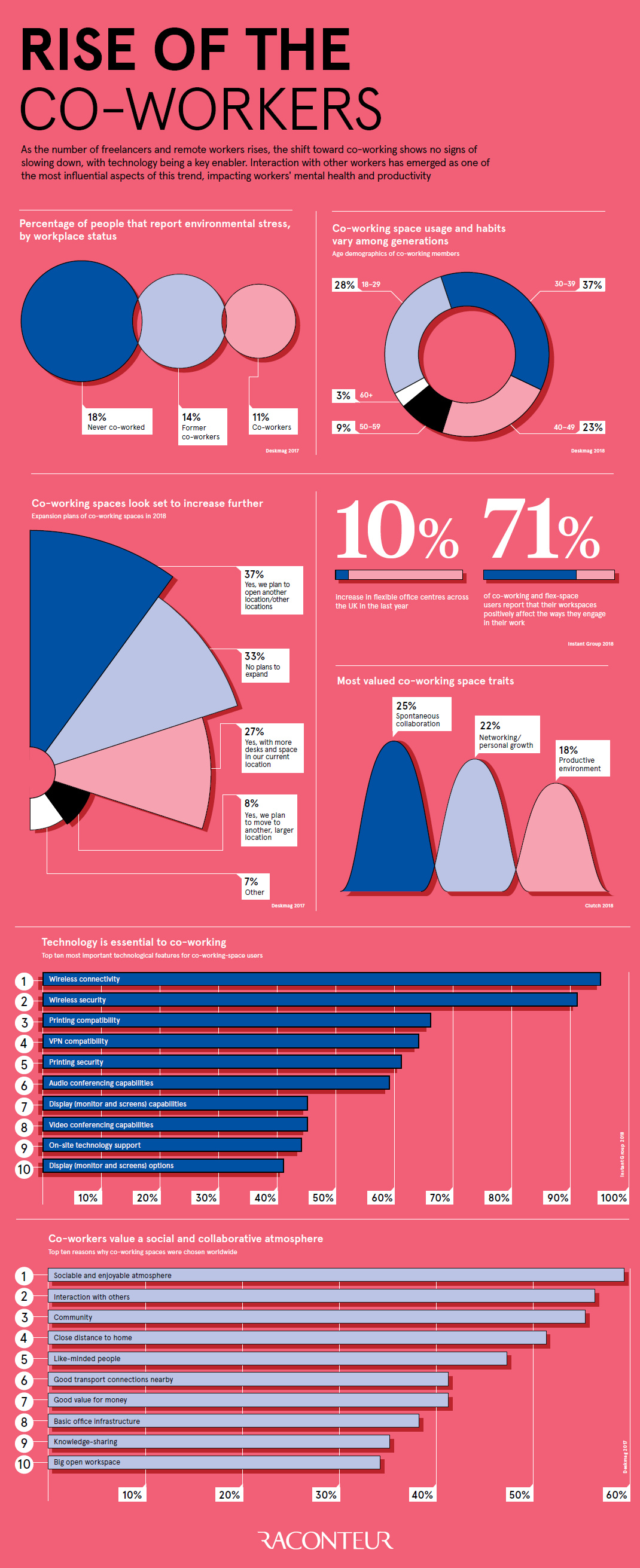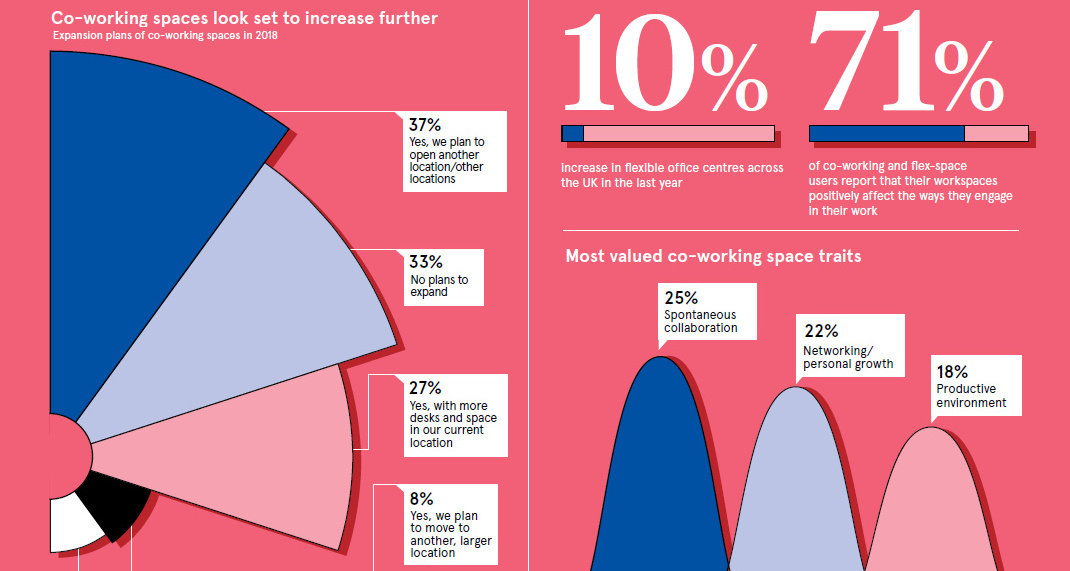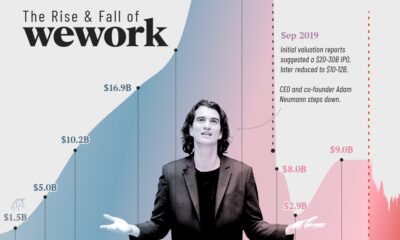Technology
Visualizing the Rise of Co-Working Spaces

Visualizing the Rise of Co-Working Spaces
In the modern era, people can work from anywhere and everywhere.
Thanks to the cloud, wireless protocols, and collaboration software, it’s possible for workers to be productive from a nearby coffee shop, another town, or a different country entirely.
While this unprecedented freedom allows us to work further apart, it’s simultaneously enabled a new business model that brings people together. The rise of co-working spaces – led by companies like WeWork – is already a multi-billion dollar industry, and a growing mainstay of startup culture.
Co-Working Together
Today’s infographic comes to us from Raconteur, and it shows why companies – and especially fast-growing startups – are increasingly gravitating towards co-working spaces.
The co-working industry offers something to startups that traditional solutions cannot, which is the ability for office space to scale with the company’s growth both seamlessly and flawlessly. Further, by covering all the essentials, from working wireless internet to an unlimited supply of coffee, this new model allows startups to focus on what matters, such as achieving product-market fit or the latest pivot.
The industry is expected to grow at a 12% CAGR over the next five years, and there’s even talk that segment-leading WeWork will be raising money at a $35 billion valuation.
Beyond the Value Prop
The prospect of “Space-as-a-Service” is certainly a compelling one for fast-growing startups, but what other valid reasons factor into the momentum behind co-working spaces?
According to co-workers themselves, here are the ten highest-ranking benefits of the model:
- Social and enjoyable atmosphere (59%)
- Interaction with others (56%)
- Community (55%)
- Close distance to my home (51%)
- Like-minded people (47%)
- Good value for money (41%)
- Good transport connections nearby (41%)
- Basic office infrastructure (38%)
- Knowledge-sharing (35%)
- Big open workspace (34%)
All in all, the value added by co-working spaces seems to be very real for the companies that call these shared spaces home.
As a result, it will be no surprise to learn that the global co-working industry is expected to expand to 30,432 spaces and 5.1 million members by 2022.
Brands
How Tech Logos Have Evolved Over Time
From complete overhauls to more subtle tweaks, these tech logos have had quite a journey. Featuring: Google, Apple, and more.

How Tech Logos Have Evolved Over Time
This was originally posted on our Voronoi app. Download the app for free on iOS or Android and discover incredible data-driven charts from a variety of trusted sources.
One would be hard-pressed to find a company that has never changed its logo. Granted, some brands—like Rolex, IBM, and Coca-Cola—tend to just have more minimalistic updates. But other companies undergo an entire identity change, thus necessitating a full overhaul.
In this graphic, we visualized the evolution of prominent tech companies’ logos over time. All of these brands ranked highly in a Q1 2024 YouGov study of America’s most famous tech brands. The logo changes are sourced from 1000logos.net.
How Many Times Has Google Changed Its Logo?
Google and Facebook share a 98% fame rating according to YouGov. But while Facebook’s rise was captured in The Social Network (2010), Google’s history tends to be a little less lionized in popular culture.
For example, Google was initially called “Backrub” because it analyzed “back links” to understand how important a website was. Since its founding, Google has undergone eight logo changes, finally settling on its current one in 2015.
| Company | Number of Logo Changes |
|---|---|
| 8 | |
| HP | 8 |
| Amazon | 6 |
| Microsoft | 6 |
| Samsung | 6 |
| Apple | 5* |
Note: *Includes color changes. Source: 1000Logos.net
Another fun origin story is Microsoft, which started off as Traf-O-Data, a traffic counter reading company that generated reports for traffic engineers. By 1975, the company was renamed. But it wasn’t until 2012 that Microsoft put the iconic Windows logo—still the most popular desktop operating system—alongside its name.
And then there’s Samsung, which started as a grocery trading store in 1938. Its pivot to electronics started in the 1970s with black and white television sets. For 55 years, the company kept some form of stars from its first logo, until 1993, when the iconic encircled blue Samsung logo debuted.
Finally, Apple’s first logo in 1976 featured Isaac Newton reading under a tree—moments before an apple fell on his head. Two years later, the iconic bitten apple logo would be designed at Steve Jobs’ behest, and it would take another two decades for it to go monochrome.
-

 Markets1 week ago
Markets1 week agoRanked: The Largest U.S. Corporations by Number of Employees
-

 Green3 weeks ago
Green3 weeks agoRanked: Top Countries by Total Forest Loss Since 2001
-

 Money2 weeks ago
Money2 weeks agoWhere Does One U.S. Tax Dollar Go?
-

 Automotive2 weeks ago
Automotive2 weeks agoAlmost Every EV Stock is Down After Q1 2024
-

 AI2 weeks ago
AI2 weeks agoThe Stock Performance of U.S. Chipmakers So Far in 2024
-

 Markets2 weeks ago
Markets2 weeks agoCharted: Big Four Market Share by S&P 500 Audits
-

 Real Estate2 weeks ago
Real Estate2 weeks agoRanked: The Most Valuable Housing Markets in America
-

 Money2 weeks ago
Money2 weeks agoWhich States Have the Highest Minimum Wage in America?







